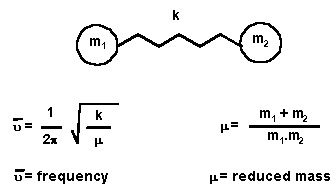| Useful Concepts |
| Useful Concepts |
An infra-red or IR spectrum is produced by absorption
of energy (4000-400 cm-1)
due to vibrations of polar covalent bonds.
This provides an important method for identifying the functional
groups within an organic molecule, the region 4000-1000 cm-1 is most useful for this.
Below 1000 cm-1 the spectra tend to be more complex and
hard to assign. However, this fingerprint region can be used to
confirm a structure by direct comparison (known vs unknown).
The most useful information you should be able to read in an IR
spectrum
is what functional groups are present.
Remember that different functional groups can be "viewed" as
combinations
of bond types, e.g. an ester is C=O and C-O.
Avoid the temptation to try to assign every peak.
| Hookes' Law | |

|
To help understand
IR, it is useful to compare a vibrating bond to
the physical model of a vibrating spring system. The spring
system
can be described by Hooke's Law, as shown in the equation given on the
left.
Consider a bond and the connected atoms to be a spring with two masses attached. Using the force constant k (which reflects the stiffness of the spring) and the two masses m1 and m2, then the equation indicates how the frequency, ν, of the absorption should change as the properties of the system change. |
As examples of this look at the positions of C-C (1000 cm-1), C=C (1600 cm-1) and C≡C (2200 cm-1), and the positions of C-H (3000 cm-1) and C-C (1000 cm-1).
The absorptions you should learn to
recognise, in order of importance
are:
m-s aromatic |
Aromatic usually in pairs |
|||
If you know these, then you can identify most of the functional groups we are interested in. Note that it is rarely useful to look for C-C since most organic molecules will have them.
Be aware that the exact substitution pattern of a particular bond causes shifts in the position of the absorption and therefore ranges of values are given in the tables. You will normally be given copies of the tables in exams, but you will save yourself lots of time if you know approximately where the various bonds absorb.
It is possible to rationalise the shifts of absorbances based on electronic effects due to proximal groups, conjugation and / or ring strain.
In general, when you are trying to work out what a molecule is, you will not just have the IR spectrum, but you will have other information as well, such as the formula or most likely the NMR. Always cross check between these sets of information, e.g. If the formula has only one O, then you cannot have an ester (CO2R) or an acid (CO2H)! or you should be able to distinguish an aldehyde and a ketone by checking the proton NMR (9-10 ppm) !
| © Dr. Ian Hunt, Department of Chemistry |